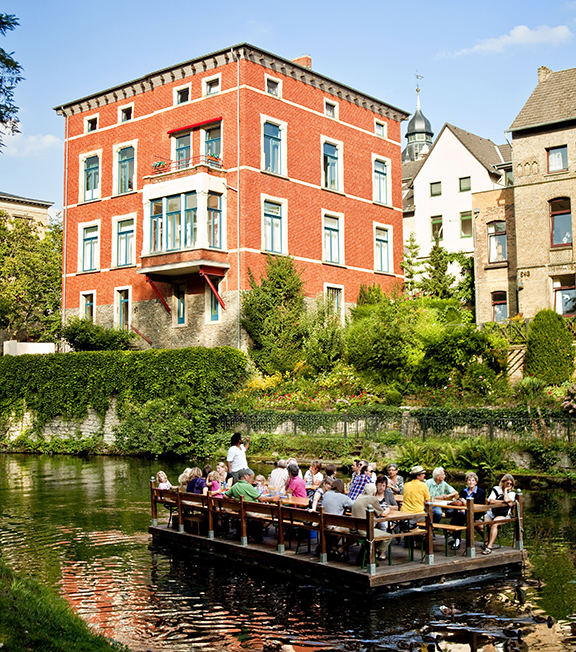Braunschweig (Brunswick) in Germany
Ancient illustrations show him as a prankster - a man in spectacular colourful clothing, a fool’s cap on his head, with an owl and a mirror in his hands. Till Eulenspiegel („Till Owlglass“) is an impudent trickster figure. He was born near the city of Brunswick around year 1300. In the stories, he is presented as a trickster who plays practical jokes on his contemporaries, exposing vices at every turn, greed and folly, hypocrisy and foolishness. Owl and mirror are the symbols for his characteristics. His tricks are based on his literal interpretation of people’s figurative language. Such as when he baked exactly what the baker of Brunswick told him to. „You fool, what do you think we are producing? Owls and monkeys?“ asked the baker. In that night Eulenspiegel had baked bread in shape of owls and monkeys – instead of bread rolls. Later on he earned a lot of money when he sold the unusual pastries. The novel about Eulenspiegel, written 1867 by Charles de Coster, has been translated into many languages.
.jpg)
Copyright Braunschweig Stadtmarketing GmbH
Thousand years
Brunswick was founded approximately 1000 years ago and roughly 850 years ago Henry the Lion expanded the city and made it his residence. Historical buildings from the Middle Ages right through to modern days bear testimony to the eventful and changing history of the city and highlight its cultural and economic importance.
Brunswick has developed into a prosperous city in the middle ages. The convenient location at the intersection of important trading routes made Braunschweig a central trading point between the Harz Mountains and the Lüneburg heath regions. Since the 13th century, Braunschweig has belonged to the Hanseatic League. Magnificent reminders of the early days of the Hanseatic town can today be experienced in the Gothic Altstadthaus (Old Town Hall) at the Altstadtmarkt (Old Town Square), the Gewandhaus (Cloth Hall) and the first civil church in the city, St. Martini.
Copyright Braunschweig Stadtmarketing GmbH
A tasty journey back into the Hanseatic times can still be experienced today with the „Brunswick Mum“. Back then, the alcoholic beer was a popular component of ships’ provisions on voyages. In the 15th and 16th centuries, the beer reached foreign shores via the navigable Oker River. Today the Brunswick Mum is a viscous, alcohol-free malt extract with which food and drink can be refined.
The Guelph Duke Henry the Lion chose Braunschweig as his ducal residence in the 12th century. The Guelph dukes continued to leave their mark on Braunschweig into the 20th century, supporting in particular culture and science. One reminder of their legacy is the mighty lion statue on the Burgplatz. In the Knappensaal of Burg Dankwarderode, elements of the Guelph treasures from the Middle Ages can be seen. In order to learn more about the history of the Guelphs in the 19th century, a visit to the castle museum in the rebuilt resident castle, as well as the adventure tour with historic characters in castle Richmond, are extremely worthwhile.
Copyright Braunschweig Stadtmarketing GmbH
Today, Brunswick is, with its approx. 250.000 inhabitants, a beautiful shopping city, lively cultural city and the centre of one of Europe's most research-intensive regions.
The historic objects, such as the lion monument as well as the residential palace, contrasting with modern buildings and passages, characterise the townscape. From the perch of residential palace you can view the whole city with the river Oker and the largest quadriga in Europe. Along the former city fortifications, villas and parks line the Oker. Raft trips on the river, whether guided or individual, provide the visitors with a very special panorama of the city.
Copyright Braunschweig Stadtmarketing GmbH
Brunswick’s museums are among the leading ones in Europe, presenting significant art treasures and collections. The city's wide range of cultural offers includes music, film and theatre festivals, top-rate exhibitions as well as numerous open-air events. Brunswick is also an ideal starting point for outings to a remarkable cultural region. The Harz Mountains and the Lüneburg Heath can also be reached in just half an hour by car.
Starting in July, Brunswick can be visited on a budget. A brand new
Youth Hostel for 160 guests will be opening its doors right in the centre of the city. It is easy to recognize it because of its V-shape. There are 44 rooms in total, ten two-bedded rooms and 34 four-bedded rooms. They are all equipped with showers and WC. Wheelchair users can use the lift to reach the rooms for the guest with a handicap. The Youth Hostel offers a large lounge with the reception and a bistro and five seminar rooms.
.jpg)
.jpg)

.jpg)
.jpg)